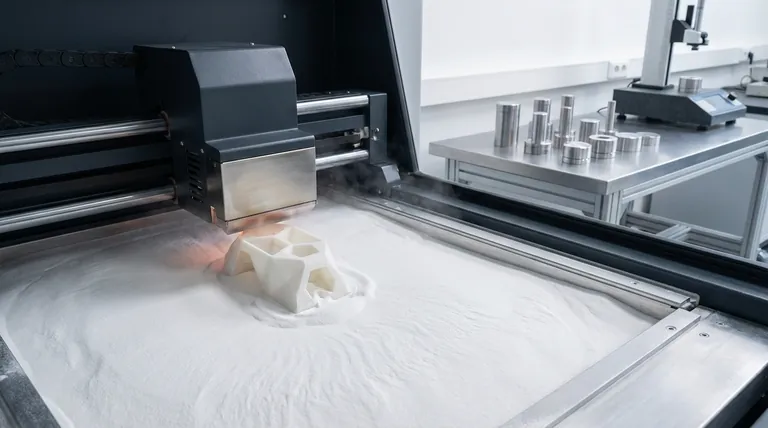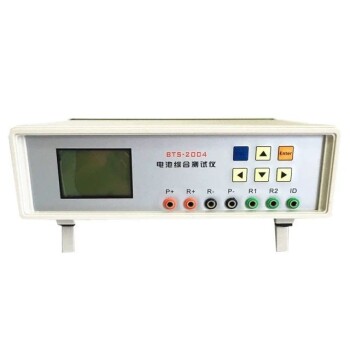In short, Selective Heat Sintering (SHS) offers a compelling low-cost entry into powder-based 3D printing, but this affordability comes with critical trade-offs in speed, resolution, and ultimate part strength. Its primary advantage is replacing the expensive laser and optics systems of other technologies with a simple thermal printhead, drastically reducing equipment cost. The main disadvantages are slower build times and less fine detail compared to its closest alternative, Selective Laser Sintering (SLS).
While the general principle of sintering is to fuse particles to increase strength and density, the method of applying heat is what defines a process. SHS's defining feature is its use of a thermal printhead, making the core decision a trade-off between its significant cost savings and the superior performance of laser-based systems.

The Core Mechanism: How SHS Works
Selective Heat Sintering is a powder bed fusion technology. Understanding its simple, layer-by-layer process is key to grasping its strengths and weaknesses.
The Powder Bed Approach
Like other powder fusion processes, SHS begins with a thin layer of polymer powder, typically a thermoplastic like nylon, spread across a build platform.
The Thermal Printhead
This is the key differentiator. Instead of a laser, SHS uses a thermal printhead, similar to those in older thermal printers, that moves across the powder bed. The printhead has numerous tiny heating elements that activate to apply heat directly to the powder below.
Sintering and Part Formation
Where heat is applied, the thermoplastic particles are sintered—heated just enough to fuse their surfaces together. The build platform then lowers, a new layer of powder is spread, and the process repeats, building a solid object layer by layer. The surrounding, unfused powder provides support for the part during the build.
Key Advantages of Selective Heat Sintering
The primary benefits of SHS all stem from its technological simplicity compared to laser-based alternatives.
Significantly Lower Equipment Cost
This is the number one advantage. A high-power laser, galvanometer mirror system, and related optics are expensive components. Replacing them with a relatively inexpensive thermal printhead makes SHS machines drastically more affordable to purchase and maintain.
No Need for Support Structures
Because the part is constantly supported by the bed of unfused powder it sits in, SHS can produce highly complex geometries, internal channels, and intricate designs without the need for breakaway support structures common in other 3D printing methods.
Good Material Properties for Prototyping
The sintering process fuses powder particles into a solid mass, creating parts that are significantly stronger and more durable than raw powder. This makes them well-suited for functional prototypes and parts that need to withstand moderate stress.
Understanding the Trade-offs: The Disadvantages
The cost advantages of SHS come with clear performance limitations that are critical to understand.
Slower Build Speeds
A thermal printhead must physically travel across the entire print area to deposit heat. In contrast, a laser in an SLS system can be directed by mirrors to scan a layer's cross-section almost instantly. This makes SHS a significantly slower process, especially for larger parts.
Lower Resolution and Feature Detail
The resolution of an SHS part is limited by the "pixel size" of the heating elements on the printhead. A laser can be focused to a much smaller spot size, allowing SLS to produce sharper corners, finer details, and thinner walls.
Potentially Weaker Parts than SLS
SHS uses thermal contact to heat the powder, which is a less efficient and lower-energy transfer method than a focused laser beam. This can result in a less complete sinter and higher porosity, leading to parts that may not be as strong or dense as those produced via SLS.
Limited Material Selection
The technology is primarily designed for use with lower-temperature thermoplastics. It cannot be used for printing metals or high-performance polymers that require the intense, focused energy of a laser or electron beam.
Making the Right Choice for Your Goal
Your decision to use SHS or an alternative depends entirely on your project's specific constraints and goals.
- If your primary focus is low-cost prototyping and geometric freedom: SHS is an excellent choice, providing access to powder-bed printing's benefits without the high capital investment of SLS.
- If your primary focus is high-resolution detail and maximum mechanical strength for end-use parts: You should strongly consider Selective Laser Sintering (SLS), as its focused energy produces denser, more detailed results.
- If your primary focus is mass production speed: Neither SHS nor SLS may be the best fit; high-speed technologies like HP's Multi Jet Fusion (MJF) or traditional manufacturing methods should be evaluated.
Ultimately, understanding SHS as a cost-effective yet deliberate process is the key to leveraging its unique position in the additive manufacturing landscape.
Summary Table:
| Aspect | Advantage | Disadvantage |
|---|---|---|
| Cost | Significantly lower equipment cost than laser-based systems | - |
| Design Freedom | No need for support structures; complex geometries possible | - |
| Speed | - | Slower build speeds compared to SLS |
| Resolution | - | Lower detail and feature resolution |
| Part Strength | Good for prototyping | Potentially weaker, more porous parts than SLS |
| Materials | Works with thermoplastics like nylon | Limited material selection (no metals/high-performance polymers) |
Need the Right Equipment for Your 3D Printing Projects?
Whether you are exploring cost-effective prototyping with technologies like Selective Heat Sintering or require high-performance solutions for end-use parts, having the right lab equipment is crucial for success.
KINTEK specializes in providing reliable lab equipment and consumables to support your additive manufacturing and R&D efforts. We can help you find the perfect tools for material testing, post-processing, and quality control, ensuring your projects meet their goals for strength, detail, and efficiency.
Contact us today using the form below to discuss how our solutions can bring precision and reliability to your laboratory.
Visual Guide

Related Products
- Polygon Press Mold for Lab
- Infrared Heating Quantitative Flat Plate Press Mold
- Square Lab Press Mold for Laboratory Applications
- Round Bidirectional Press Mold for Lab
- Chemical Vapor Deposition CVD Equipment System Chamber Slide PECVD Tube Furnace with Liquid Gasifier PECVD Machine
People Also Ask
- What is a pellet die? A Guide to Creating Uniform Solid Samples from Powder
- How much does a production mold cost? A Strategic Guide to Injection Mold Pricing
- What is a pressing die? The Precision Tool for Shaping Powder into Solid Pellets
- Is it fitting the mould or mold? A Guide to Correct Spelling by Region
- What is the press mould method? A Guide to Consistent, Detailed Ceramic Forms


















